Your skin is the first thing that everyone notices in you. It’s the first impression that you leave on somebody.
Everyone has a unique combination of dryness, oiliness, and sensitivity. Understanding your skin type is important to take care of it properly.
To help you with what your skin type is? I discussed the most common different skin types in this article.
Keep reading!
What is skin type?
Skin types are a classification system used to describe the overall characteristics of the skin.
This classification system was developed by dermatologists and helped you understand your skin type and which products are best suited for your needs.
The classification of different skin types:
The skin types are based on each individual’s relative amounts of sebum and oil.
Skin type determines the rate at which the skin will dry out and require moisturizing.
Sebum or oil content: The amount of oil in the skin provides suppleness to your skin.
Water content: The amount of water content in your skin adds elasticity to the skin.
Skin barrier: The thickness of the outermost layer of your skin that protects your skin.
Moisturizing factor: The amount of moisture content in the skin provides hydration from within to your skin.

There are several differences between each skin type and how they react to their environment.
Why is it important to know your skin type?
Your skin type is important because it can help you determine which products are best for your skin.
For example, if you have dry skin, it’s important to use a moisturizer to hydrate your skin.
On the other hand, if you have oily skin, you’ll want to use a product that will help reduce the amount of oil your skin produces.
Knowing your skin type can also help you identify any potential skin problems that you may have and take steps to prevent them from getting worse.
What are the most common types of skin?
The most common different skin types that you can identify quickly are normal, oily, dry, flaky, combination, acne-prone, and sensitive:
1. Normal Skin Type
What is a normal skin type?
Technically, there is no such thing as a “normal” skin type. Everyone has a unique skin type that may react differently to different products and treatments.
However, normal skin is not too dry or too oily and is not sensitive.
It has a healthy balance of oils and moisture and does not usually experience problems like acne or rosacea. It can stay moisturized all day without feeling tight or greasy.
Normal skin is the type of skin that does not need much attention. It is also known as healthy skin.
How do you know if your skin is normal?
Normal skin characteristics:
- It can stay moisturized all day without feeling tight or greasy.
- It can have a balanced amount of oil and moisture.
- It feels smooth and soft.
- It does not break easily.
How to take care of the normal skin type?

Normal skin is usually clear, smooth, and soft, requiring less attention.
Some people with normal skin may only need to wash their face once daily with a mild soap, while others may need a more specialized cleanser and moisturizer.
Finding the right products for your particular skin type and sticking to a routine is necessary.
Sunscreen is also essential for anyone with normal skin, as sun exposure can cause sunburns and other damage.
Choose a sunscreen labeled “broad spectrum” with an SPF of 30 or higher.
Apply sunscreen every day, including in the winter, and be sure to reapply if you swim or sweat.
Besides, you must take a balanced diet and stay hydrated.
2. Dry Skin Type
What is dry skin type?
Dry skin is characterized by a lack of sebum, the oil produced by the sebaceous glands to keep the skin lubricated. This can make the skin feel tight, dry, and itchy. Dry skin can also be more susceptible to flaking and cracking.
How do you know if your skin is dry?
Dry skin characteristics:
- It has rough patches, flakes, or scales.
- It feels tight or itchy.
- It breaks easily.
- It looks dull and lifeless.
- It needs moisturizing frequently.
- It does not have much oil or moisture.
- It does not have good elasticity.
- It is prone to flaking and cracking.
- It can feel rough, itchy, and tight after washing.
- It is sensitive to the environment and may be prone to redness.
- It is more likely to show signs of aging and wrinkles
It can be caused due to:
- Environmental factors include cold weather or wind, age, certain medications, and health conditions such as diabetes or thyroid disease.
- Poor skincare
- Lack of moisture in the air.
- Poor diet
- Lack of hydration
How to take care of dry skin type?
Dry skin requires special attention.
One of the most common skin complaints is dry skin. Dry skin can be caused by various factors, including genetics, environmental conditions, and lifestyle choices. If you have dry skin, it is important to take steps to improve the moisture levels in your skin.
You can do many things to take care of dry skin type:
Make sure to drink plenty of water each day. Dehydration can lead to dry skin.
Apply a moisturizer liberally to your skin after bathing or showering. Look for a moisturizer that contains humectants such as glycerin or hyaluronic acid, which help draw moisture into the skin.
Avoid harsh soaps on your face. Soaps can overdry your skin, stripping away the natural oils that protect your skin from drying out. Instead, opt for a natural or mild soap-free cleanser.
Avoid using hot water when washing your face or taking a shower.
3. Flaky Skin Type
What is a flaky skin type?
Flaky skin type is a condition that causes the skin to become dry, itchy, and cracked. The main symptom of flaky skin type is the appearance of small, white flakes on the skin’s surface.
Flaky skin types can be treated with over-the-counter moisturizers and anti-itch creams. If the condition persists, see a doctor.

How do you know if your skin is flaky?
Flaky skin characteristics:
- It flakes off easily.
- It feels rough and itchy.
- It looks dull and lifeless.
- It needs moisturizing frequently.
- It needs to be cleaned off frequently.
It can be caused due to:
- Combination of dry air and cold weather
- Lack of moisture in the air.
- Sunburn, eczema, psoriasis, and contact dermatitis
- Poor diet Lack of hydration
- Allergy
How to take care of flaky skin type?
Your skin can become dry for various reasons, including weather changes, harsh soaps, or being in the sun too long if you have a flaky skin type.
These tips can help you take care of your skin and keep it looking healthy:
1. Drink plenty of water to help hydrate your skin from the inside out.
2. Use a gentle soap that doesn’t contain harsh chemicals or detergents.
3. Apply a moisturizer to your skin after bathing while still damp to help seal in moisture.
4. Avoid using hot water when bathing or washing your face, as it can strip away natural oils from your skin.
5. Use a humidifier in your home during the winter months when the air is dry to help add moisture to the air and prevent your skin from drying out.
6. Exfoliate your skin. If you have flaky skin, exfoliation can help remove the dead skin cells and help you achieve a more even complexion. Try a mild scrub to exfoliate your skin, and gently rinse with warm water.
7. You must also take a healthy diet.
4. Oily Skin Type
What is oily skin type?
Oily skin is caused by overactive sebaceous glands that produce too much oil. The skin looks and feels oily, greasy, shiny, and thick.
It is more common in young adults and teenagers but can occur at any age. Oily skin may have an acne problem.
How do you know if your skin is oily?
Signs of oily skin:
- It is shiny and greasy.
- It may be itchy.
- It has blackheads or whiteheads.
- It has a lot of shine.
- It is prone to acne.
- It has large pores.
- It produces excessive oil and sweat.
- It is prone to inflammation.
- It may appear bumpy and flaky.
- It is sensitive to the environment and may be prone to redness.
- It is prone to acne breakouts.
- It is more likely to show signs of aging and wrinkles.
It can be caused due to:
- Genetics
- Hormonal changes
- Eating junk food.
- Over exfoliation
- Using wrong moisturizers
- Not drinking enough water
How to take care of oily skin type?
If you have an oily skin type, you will likely notice that your skin is shiny and produces a lot of oil throughout the day. This can lead to acne breakouts and other skin problems.
To take care of your oily skin, you should:
- Wash your face twice daily with a gentle cleanser for oily skin. Make sure to rinse your face thoroughly after washing.
- Use a light moisturizer if your skin feels dry. A moisturizer for oily skin can help control the amount of oil your skin produces.
- Avoid using products that contain alcohol or fragrance, which can aggravate oily skin.
- If you get acne breakouts, use an acne medication prescribed by your doctor. It can help reduce the amount of oil your skin produces and make it easier to control the appearance of acne breakouts.
5. Combination Skin Type
What is a combination skin type?
A combination skin type is a skin type that is not dry but also not oily. This skin type is the most common. It is characterized by areas of dryness and oiliness on the face.
How do you know if your skin is the combination?
Combination of skin characteristics:
- It is not too dry or too oily and is not sensitive.
- It is sometimes oily in the T-zone.
- It has blackheads or whiteheads.
- It may have large pores.
- It can be dehydrated, especially on the nose.
- It can be more sensitive to cosmetics and fragrances.
- It can be prone to acne breakouts.
- It can be prone to rosacea.
- It can feel tight or dry.
- It tends to show lines, wrinkles, and age spots.
It can be caused due to:
- Genetics
- Hormonal changes
- Climate change
- Eating junk food
- Poor skincare
How to take care of combination skin?
Combination skin is the most common skin type. It’s dry in some areas and oily in others. If you have combination skin, you need to take care of it differently than people with other skin types.
Here are a few tips to take care of flaky skin type:
- You should use a gentle cleanser that won’t strip your skin of its natural oils.
- You must also use a moisturizer to hydrate your skin without making it oily. A good rule of thumb is to apply more moisturizer to the drier parts of your face and less moisturizer to the oily parts.
- You should also avoid using too harsh products or containing alcohol, which can cause your skin to become dry and irritated.
- You must have a healthy and balanced diet.
- And finally, make sure you drink plenty of water each day, which will help keep your skin hydrated from the inside out.
6. Sensitive Skin Type
What is a sensitive skin type?
Sensitive skin is a skin type that is prone to irritation and sensitivity. People with sensitive skin often experience skin easily irritated by the sun, wind, cold weather, and other environmental factors. Their skin may also be more sensitive to certain products, including cosmetics and skincare products.
How do you know if you have sensitive skin?
Sensitive skin characteristics:
- It may feel tight and itchy
- It reacts easily to many skincare products
- It reacts to home remedies
- It may feel like you have bumps on your face
- It may have open pores
- It becomes oily and dry with changing seasons
- It is prone to inflammation.
- It is prone to rashes.
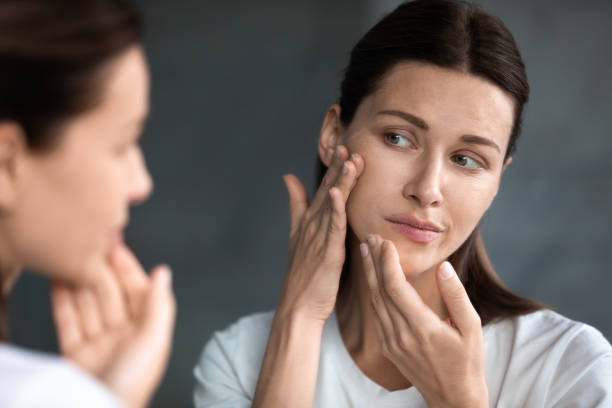
It can be caused due to:
- Being allergic to something
- Having hormonal problems
- Poor skincare
- Poor diet
- Stress
- Allergic to skincare products
- Whether conditions
- Lack of moisture and hydration
How to take care of sensitive skin types?
If you have sensitive skin, you must take care of it properly. Here are a few tips:
- First, identify what triggers your skin to react. Common triggers include fragrances, alcohol, and other harsh chemicals.
- Avoid using any products that contain these ingredients. Instead, opt for gentle and natural alternatives.
- Moisturize your skin regularly, especially if it’s dry or irritating. Choose a moisturizer that is free of harsh chemicals and fragrances.
- Use a gentle soap or cleanser when washing your face. Avoid scrubbing your skin too hard or using products that are too harsh.
- Be careful when choosing sunscreens and other cosmetics. Choose products that are labeled as “sensitive” or “hypoallergenic.”
7. Acne-prone Skin Type
What is an acne-prone skin type?
Acne-prone skin type is more prone to acne. Acne is a skin condition that consists of blackheads, whiteheads, and pimples. Acne can occur on the face, chest, back, and shoulders.
Overactive oil glands and clogged pores cause acne-prone skin. Pores become clogged with oil and dead skin cells.
Bacteria can also cause acne. Acne-prone skin can be treated with over-the-counter or prescription medications.
How do you know if you have acne-prone skin?
Acne-prone skin characteristics:
- It is usually oily with clogged pores.
- It has a lot of oil production and is often oily.
- It feels tight and shiny.
- It is usually red or inflamed.
- It tends to be sensitive to most cosmetic products.
- It often has blackheads and whiteheads.
- It tends to feel itching with red marks that are often filled with pus
It can be caused due to:
- Hormonal imbalance
- Sugar intake
- Overexposure to sunlight
How to take care of acne-prone skin type?
Acne-prone skin is the most common skin type worldwide. It’s estimated that over 50 million Americans have some form of acne.
Acne is caused when the pores on your face become clogged with oil and dead skin cells. The result is blackheads, whiteheads, and pimples.
If you have acne-prone skin, there are a few things you can do to help keep your skin clear:
1. Ensure to wash your face twice a day with a gentle cleanser. Don’t scrub your skin or use harsh soap.
2. Use a moisturizer that is labeled “non-comedogenic.” This means it won’t clog your pores.
3. Avoid touching your face with your hands or fingers.
4. Don’t wear makeup if you don’t have to.
5. Wash your pillowcases and towels in hot water to get rid of the oils that build upon them overnight.
6. If you have severe painful acne, don’t try home remedies or online advice. Instead, meet your dermatologist for the proper treatment.
How to Know your Skin Type?
Blotting sheet method:
The method of blotting sheet is used for the identification of skin types. It’s based on the idea that the skin’s oiliness can be determined by pressing a piece of blotting paper against it. Blotting paper or tissue paper is required for this method.
Step 1: Wash your face with a cleanser or face wash, and leave it as it is without applying anything, not even moisturizer.
Step 2: Wait for an hour in a room or place at normal temperature. Avoid sitting in a room with air-conditioning or a room heater.
Step 3: After an hour, notice if your skin feels tight, oily, shiny, itchy, or dry.
Step 4: Take a piece of blotting paper or tissue paper. And place it on your face, including your forehead, nose, cheeks, and chin.
Step 5: Press the blotting or tissue paper firmly for a few seconds.

Check the Results of the blotting paper method:
Normal skin type: If you don’t feel any oiliness, dryness, or itching, you have normal skin.
Oily skin type: If your skin is oily, it will stick to it. You’ll notice oil over your face and on the paper.
Dry Skin type: If your skin is dry, the paper will not stick to it, and your skin feels dry, tight, and itchy.
Combination skin type: If you find your face shiny and oily on your T zone while other parts of your face are dry, you have combination skin.
Sensitive skin type: If you feel redness, dryness, and itchiness, you have sensitive skin.
What are the T zone and C zone?
The forehead, chin, and nose are referred to as T-zone. Cheeks and other areas around the T zone are referred to as the C zone.
Bare Face Method:
By observing your skin surface, you can also identify your skin type without blotting or tissue paper.
Step 1: Wash your face with a mild cleanser, and don’t apply anything to your face.
Step 2: Wait for an hour at normal room temperature.
Step 3: Observe your face surface in a mirror by touching it with clean hands.
Results of Bare face method:
Normal skin type: You’ll not feel any oiliness, dryness, or itching on your face.
Oily skin v: Your entire face, including your T and C zones, becomes oily.
Dry skin type: you’ll feel dryness and itching on your face.
Combination skin type: You’ll feel dryness on your cheeks and oiliness in your T zone.
Sensitive type: Your face becomes red, itchy, and dry.
Overnight skin type test
You can do this overnight test to determine whether your skin’s normal, oily, dry, or sensitive.
Step 1: Wash your face with a mild cleanser before sleeping
Step 2: Don’t apply anything over your face.
Step 3: Wake up in the morning and carefully observe your face in the mirror.
Results of Overnight skin type method:
Normal skin type: You’ve normal skin if you wake up with a fresh, smooth oil-free face. You’ve normal skin if your T zone is a bit oily and you don’t feel dryness or itching.
Oily skin type: Your T zone face becomes oily and dark, including your T and C zones.
Oily acne-prone type: If you have a lot of oil over your face and large pores on your T zone, you’ve oily skin. You are more likely to get acne issues.
Dry skin type: If you feel dryness and itching on your face, you have dry skin.
Flaky skin type: If you feel your skin extremely tight, dry, and flaky, you have flaky and dehydrated skin that needs extra care.
Combination skin type: If You feel some dryness on your cheeks and oiliness on your T zone, you have combination skin.
Sensitive skin type: If you got sensitive skin, your face becomes red, itchy, and dry. If you splash water over your face, it may also feel irritating.
Do you have any skin issues?
If you face any skin issues like severe acne, allergies, and pigmentation, you must get a professional opinion and find out what product you need. Always remember, it’s best to use products made specifically for you.
Can Your Skin Type Change?
Most people think their skin type is static and unchanging, but this isn’t always the case. Studies have shown that the skin’s properties can change over time due to various factors such as age, environment, and lifestyle.
Sometimes, a person’s skin type can flip completely – going from oily to dry, for example.
Your skin type can change with time due to many factors:
- Sun exposure
- Weather
- Age
- Hormonal changes
- Weight loss/gain
- Diets
- Medication
- Smoking
- Stress
- Lifestyle
- Health conditions
Besides this, when a woman goes through menopause, her body produces less estrogen and progesterone. This can lead to many changes in the skin, including increased dryness and sensitivity.
Tips to change your skin type:
You can change your skin type from dry to oily, oily to normal, or vice-versa by following some simple steps:
1. Wash your face with a mild cleanser. Use a face wash or cleanser as per your skin type.
2. Apply a moisturizer that suits your skin type. This will prevent the skin from drying out.
3. Apply good sunscreen on your face, especially when you step outside.
5. Drink plenty of water and stay hydrated.
6. Eat a balanced diet and avoid junk food.
7. Stay active and incorporate some exercise, yoga, or meditation into your lifestyle.
8. Take enough sleep.
9. Avoid alcohol or smoking.
10. avoid stress and anxiety.
Now let me know
What’s your Skin Type?

